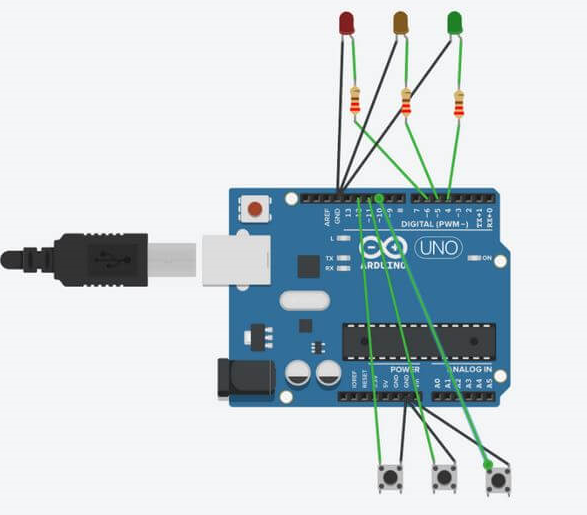在实习的期间为公司写的红绿灯检测,基于YOLOv3的训练好的权重,不需要自己重新训练,只需要调用yolov3.weights,可以做到视频或图片中红绿灯的检测识别。
自动检测识别效果
1.红灯检测
2.绿灯检测
python源码
"""
Class definition of YOLO_v3 style detection model on image and video
"""
import colorsys
import os
from timeit import default_timer as timer
import cv2
import numpy as np
from keras import backend as K
from keras.models import load_model
from keras.layers import Input
from PIL import Image, ImageFont, ImageDraw
from yolo3.model import yolo_eval, yolo_body, tiny_yolo_body
from yolo3.utils import letterbox_image
import os
from keras.utils import multi_gpu_model
import collections
class YOLO(object):
_defaults = {
"model_path": ''model_data/yolo.h5'',
"anchors_path": ''model_data/yolo_anchors.txt'',
"classes_path": ''model_data/coco_classes.txt'',
"score" : 0.3,
"iou" : 0.35,
"model_image_size" : (416, 416),
"gpu_num" : 1,
}
@classmethod
def get_defaults(cls, n):
if n in cls._defaults:
return cls._defaults[n]
else:
return "Unrecognized attribute name ''" + n + "''"
def __init__(self, **kwargs):
self.__dict__.update(self._defaults) # set up default values
self.__dict__.update(kwargs) # and update with user overrides
self.class_names = self._get_class()
self.anchors = self._get_anchors()
self.sess = K.get_session()
self.boxes, self.scores, self.classes = self.generate()
def _get_class(self):
classes_path = os.path.expanduser(self.classes_path)
with open(classes_path) as f:
class_names = f.readlines()
class_names = [c.strip() for c in class_names]
return class_names
def _get_anchors(self):
anchors_path = os.path.expanduser(self.anchors_path)
with open(anchors_path) as f:
anchors = f.readline()
anchors = [float(x) for x in anchors.split('','')]
return np.array(anchors).reshape(-1, 2)
def generate(self):
model_path = os.path.expanduser(self.model_path)
assert model_path.endswith(''.h5''), ''Keras model or weights must be a .h5 file.''
# Load model, or construct model and load weights.
num_anchors = len(self.anchors)
num_classes = len(self.class_names)
is_tiny_version = num_anchors==6 # default setting
try:
self.yolo_model = load_model(model_path, compile=False)
except:
self.yolo_model = tiny_yolo_body(Input(shape=(None,None,3)), num_anchors//2, num_classes)
if is_tiny_version else yolo_body(Input(shape=(None,None,3)), num_anchors//3, num_classes)
self.yolo_model.load_weights(self.model_path) # make sure model, anchors and classes match
else:
assert self.yolo_model.layers[-1].output_shape[-1] ==
num_anchors/len(self.yolo_model.output) * (num_classes + 5),
''Mismatch between model and given anchor and class sizes''
print(''{} model, anchors, and classes loaded.''.format(model_path))
# Generate colors for drawing bounding boxes.
hsv_tuples = [(x / len(self.class_names), 1., 1.)
for x in range(len(self.class_names))]
self.colors = list(map(lambda x: colorsys.hsv_to_rgb(*x), hsv_tuples))
self.colors = list(
map(lambda x: (int(x[0] * 255), int(x[1] * 255), int(x[2] * 255)),
self.colors))
np.random.seed(10101) # Fixed seed for consistent colors across runs.
np.random.shuffle(self.colors) # Shuffle colors to decorrelate adjacent classes.
np.random.seed(None) # Reset seed to default.
# Generate output tensor targets for filtered bounding boxes.
self.input_image_shape = K.placeholder(shape=(2, ))
if self.gpu_num>=2:
self.yolo_model = multi_gpu_model(self.yolo_model, gpus=self.gpu_num)
boxes, scores, classes = yolo_, self.input_image_shape,
score_threshold=self.score, iou_threshold=self.iou)
return boxes, scores, classes
def getColorList(self):
dict = collections.defaultdict(list)
# 红色
lower_red = np.array([156, 43, 46])
upper_red = np.array([180, 255, 255])
color_list = []
color_list.append(lower_red)
color_list.append(upper_red)
dict[''red''] = color_list
# 红色2
lower_red = np.array([0, 43, 46])
upper_red = np.array([10, 255, 255])
color_list = []
color_list.append(lower_red)
color_list.append(upper_red)
dict[''red2''] = color_list
# 橙色
lower_orange = np.array([11, 43, 46])
upper_orange = np.array([25, 255, 255])
color_list = []
color_list.append(lower_orange)
color_list.append(upper_orange)
dict[''orange''] = color_list
# 黄色
lower_yellow = np.array([26, 43, 46])
upper_yellow = np.array([34, 255, 255])
color_list = []
color_list.append(lower_yellow)
color_list.append(upper_yellow)
dict[''yellow''] = color_list
# 绿色
lower_green = np.array([35, 43, 46])
upper_green = np.array([77, 255, 255])
color_list = []
color_list.append(lower_green)
color_list.append(upper_green)
dict[''green''] = color_list
return dict
def get_color(self,frame):
print(''go in get_color'')
hsv = cv2.cvtColor(frame, cv2.COLOR_BGR2HSV)
maxsum = -100
color = None
color_dict = self.getColorList()
score = 0
type = ''black''
for d in color_dict:
mask = cv2.inRange(hsv, color_dict[d][0], color_dict[d][1])
# print(cv2.inRange(hsv, color_dict[d][0], color_dict[d][1]))
#cv2.imwrite(''images/triffic/'' + f + d + ''.jpg'', mask)
binary = cv2.threshold(mask, 127, 255, cv2.THRESH_BINARY)[1]
binary = cv2.dilate(binary, None, iterations=2)
img, cnts, hiera = cv2.findContours(binary.copy(), cv2.RETR_EXTERNAL, cv2.CHAIN_APPROX_SIMPLE)
sum = 0
for c in cnts:
sum += cv2.contourArea(c)
if sum > maxsum:
maxsum = sum
color = d
if sum > score:
score = sum
type = d
return type
def detect_image(self, image,path):
print(''class'',self._get_class())
start = timer()
if self.model_image_size != (None, None):
assert self.model_image_size[0]%32 == 0, ''Multiples of 32 required''
assert self.model_image_size[1]%32 == 0, ''Multiples of 32 required''
boxed_image = letterbox_image(image, tuple(reversed(self.model_image_size)))
else:
new_image_size = (image.width - (image.width % 32),
image.height - (image.height % 32))
boxed_image = letterbox_image(image, new_image_size)
image_data = np.array(boxed_image, dtype=''float32'')
print(image_data.shape)
image_data /= 255.
image_data = np.expand_dims(image_data, 0) # Add batch dimension.
out_boxes, out_scores, out_classes = self.sess.run(
[self.boxes, self.scores, self.classes],
feed_dict={
self.yolo_model.input: image_data,
self.input_image_shape: [image.size[1], image.size[0]],
K.learning_phase(): 0
})
print(''Found {} boxes for {}''.format(len(out_boxes), ''img''))
font = ImageFont.truetype(font=''font/FiraMono-Medium.otf'',
size=np.floor(3e-2 * image.size[1] + 0.5).astype(''int32''))
thickness = (image.size[0] + image.size[1]) // 300
thickness = 5
print(''thickness'',thickness)
print(''out_classes'',out_classes)
my_class = [''traffic light'']
imgcv = cv2.cvtColor(np.asarray(image), cv2.COLOR_RGB2BGR)
for i, c in reversed(list(enumerate(out_classes))):
predicted_class = self.class_names[c]
print(''predicted_class'',predicted_class)
if predicted_class not in my_class:
continue
box = out_boxes[i]
score = out_scores[i]
label = ''{} {:.2f}''.format(predicted_class, score)
draw = ImageDraw.Draw(image)
label_size = draw.textsize(label, font)
top, left, bottom, right = box
top = max(0, np.floor(top + 0.5).astype(''int32''))
left = max(0, np.floor(left + 0.5).astype(''int32''))
bottom = min(image.size[1], np.floor(bottom + 0.5).astype(''int32''))
right = min(image.size[0], np.floor(right + 0.5).astype(''int32''))
print(label, (left, top), (right, bottom))
img2 = imgcv[top:bottom, left:right]
color = self.get_color(img2)
cv2.imwrite(''images/triffic/''+path+str(i) + ''.jpg'', img2)
if color== ''red'' or color == ''red2'':
cv2.rectangle(imgcv, (left, top), (right, bottom), color=(0, 0, 255),
lineType=2, thickness=8)
cv2.putText(imgcv, ''{0} {1:.2f}''.format(color, score),
(left, top - 15),
cv2.FONT_HERSHEY_SIMPLEX,
1.2, (0, 0, 255), 4,
cv2.LINE_AA)
elif color == ''green'':
cv2.rectangle(imgcv, (left, top), (right, bottom), color=(0, 255, 0),
lineType=2, thickness=8)
cv2.putText(imgcv, ''{0} {1:.2f}''.format(color, score),
(left, top - 15),
cv2.FONT_HERSHEY_SIMPLEX,
1.2, (0, 255, 0), 4,
cv2.LINE_AA)
else:
cv2.rectangle(imgcv, (left, top), (right, bottom), color=(255, 0, 0),
lineType=2, thickness=8)
cv2.putText(imgcv, ''{0} {1:.2f}''.format(color, score),
(left, top - 15),
cv2.FONT_HERSHEY_SIMPLEX,
1.2, (255, 0, 0), 4,
cv2.LINE_AA)
print(imgcv.shape)
end = timer()
print(end - start)
return imgcv
def close_session(self):
self.sess.close()
def detect_img(yolo, img_path,fname):
img = Image.open(img_path)
import time
t1 = time.time()
img = yolo.detect_image(img,fname)
print(''time: {}''.format(time.time() - t1))
return img
#yolo.close_session()
if __name__ == ''__main__'':
yolo = YOLO()
video_full_path = ''images/triffic.mp4''
output = ''images/res.avi''
cap = cv2.VideoCapture(video_full_path)
cap.set(cv2.CAP_PROP_POS_FRAMES, 1) # 设置要获取的帧号
fourcc = cv2.VideoWriter_fourcc(*''XVID'')
fps = cap.get(cv2.CAP_PROP_FPS)
size = (int(cap.get(cv2.CAP_PROP_FRAME_WIDTH)), int(cap.get(cv2.CAP_PROP_FRAME_HEIGHT)))
out = cv2.VideoWriter(output, fourcc, fps, size)
ret = True
count = 0
while ret :
count+=1
ret, frame = cap.read()
if not ret :
print(''结束'')
break
image = Image.fromarray(cv2.cvtColor(frame,cv2.COLOR_BGR2RGB))
image = yolo.detect_image(image,''pic'')
out.write(image)
cap.release()
out.release()
cv2.destroyAllWindows()
声明:本文内容及配图由入驻作者撰写或者入驻合作网站授权转载。文章观点仅代表作者本人,不代表电子发烧友网立场。文章及其配图仅供工程师学习之用,如有内容侵权或者其他违规问题,请联系本站处理。
举报投诉
-
检测识别
+关注
关注
0文章
9浏览量
7237 -
python
+关注
关注
56文章
4795浏览量
84660
发布评论请先 登录
相关推荐
交通红绿灯
本帖最后由 samuergao 于 2014-7-3 14:13 编辑
交通灯,并显示当前时间和倒计时,包含了单条路遇到人行道的红绿灯,还有十字路口的红绿灯,大家帮看看有的改进没有。
发表于 07-03 12:12
红绿灯的供电状况解析
很多红绿灯则是“黑户”(并不代表违规哦),它们的电则是从附近“借”来的,来源也是五花八门:附近的路灯、企业、公变台区等等……这些红绿灯,供电公司一般是不知道它的运行情况的
红绿灯识别知识点
红绿灯识别是自动驾驶中最为基础的功能,识别方法主要有两种,一种基于视觉图像识别,一种基于v2x。
v2x,即通过红绿灯自己实时发送信号状态
发表于 06-06 09:54
•0次下载





 基于YOLOv3的红绿灯检测识别(Python源码可直接运行)
基于YOLOv3的红绿灯检测识别(Python源码可直接运行)












评论